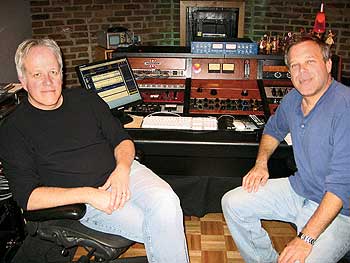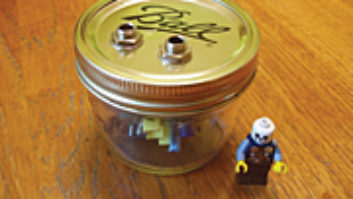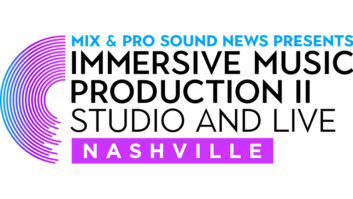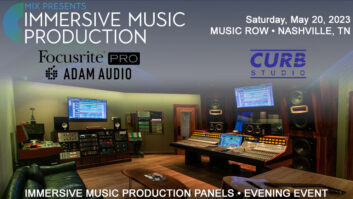
Don Cobb (left) and Eric Conn of Nashville’s Independent Mastering
Photo: Peter Cooper
Eric Conn’s life shifted with the change of a head stack.
“I was a music major in college, but I didn’t know anything about recording and I’d never even heard of mastering,” says Conn, who runs Independent Mastering in Nashville with friend and fellow musician Don Cobb. “A friend was doing a project at Doug Sax’s Mastering Lab [then in Hollywood], and I walked in there and Doug changed the head stack on a tape machine, and all of a sudden the sound changed. That moment was where I fell in love with mastering, and thought, ‘Whoa, this is what I want to do.’”
Conn wound up working at Sax’s Sheffield Lab Recording for three years, and then at Denny Purcell’s Georgetown Masters for four years. Cobb was also a staff member at Georgetown, where he worked for 14 years under Purcell, perhaps the most celebrated and best-loved mastering engineer in Nashville history.
“I started as a recording and mix engineer,” says Cobb, who worked in that capacity with James Taylor, Quincy Jones, Waylon Jennings and others. “In the studio, it’s a great process, but mastering is a little more sane schedule. What’s interesting to me is that someone comes in with a data drive or a reel-to-reel tape or whatever it is, full of different mixes, and you spend the day EQ’ing and editing, and at the end of the day you can have a complete album. You get the excitement of the project, and the next day you’re on to something else.”
Since opening Independent Mastering in 2001, Conn and Cobb have mastered music from Garth Brooks, Kenny Chesney, George Strait, Martina McBride, Earl Scruggs, Janis Ian and numerous others, yet they talk as enthusiastically about the recent Chris Pandolfi album as about any million-seller. Pandolfi, after all, is a particularly deft Nashville banjo man, and his Looking Glass album — well, it sounds good.
By background and inclination, Conn and Cobb are musicians who concern themselves with signal path rather than engineers who concern themselves with music. “We do a lot of educating here, about levels and retaining dynamic range versus being competitive in the marketplace,” Conn says. “We have conversations regularly about where people want to fit in the marketplace. Does someone really need to be as loud as Nickelback? A lot of clients are saying, ‘No, I don’t need it that loud.’ If all they want is for it to be loud, we can do that, but we show everyone the other options and show them what they’re gaining or missing.”
The board at Independent Mastering is a custom job that started in Conn’s living room.
“We wanted simplicity and a good signal path,” he says. “Everything in the signal path is discrete and a lot of it is unbalanced. It’s just simple: Less is more. It’s the same with the monitors. We went through six months of listening to different monitor boxes, and we couldn’t find anything that sounded better than what we built, which basically has a couple of switches and an attenuator. You can put relays in and complicated switching and a lot of pretty lights, and you may wind up with something that looks good and sounds like crap.”
Conn and Cobb operate on a “four ears is better than two” system, working through most projects together, though Conn tends to deal more with equalization while Cobb handles the bulk of the editing duties.
“The common denominator is the Sonic Solutions editing system we use,” Cobb says. “We rely on that, daily, and it’s a great system.”
The studio monitors are based on Pioneer components, but they’re custom jobs as well, with Bryston amplifiers on the low end and McIntoshes on top. “We used to have near-fields up, and we like these so much that we don’t even use the near-fields anymore,” Cobb says.
Independent Mastering is located in the same complex as Masterlink, the studio that was formerly Monument and that has housed sessions by Neil Young, Kris Kristofferson and many others. Every now and again, Cobb and Conn record something at Masterlink, always for fun and always live to 2-track.
“We like that because we’re musicians,” Conn says. “I think one thing that puts us at a good place in this game is that we know what acoustic instruments sound like, so there’s a benchmark for fidelity and a benchmark for the way an acoustic instrument sounds in real life. We’ve got four different sets of line amps, and two are solid-state, and each one sounds different. Spending the time to know the gear is an important part in the process, and the goal is to make the instruments sound like instruments. Some people feel that they must impart their signature on a record, but we don’t feel that way: The mix engineer and the artist have worked hard to achieve that level of integrity with the mix, and it’s not our job to change it. We’d rather the artists create their signature, and we’re just part of the process to make sure that comes through.”
Peter Cooper can be reached at
[email protected].





